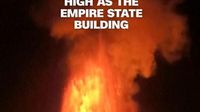The mighty Kīlauea volcano on Hawaii’s Big Island has once again captured the world’s attention, erupting for the 34th time in a dramatic display of nature’s power before abruptly pausing activity on the morning of October 2, 2025. According to the USGS Hawaiian Volcano Observatory, this latest episode—aptly named Episode 34—offered a breathtaking, albeit brief, spectacle of towering lava fountains, surging flows, and billowing plumes, all while scientists and residents alike watched with a mix of awe and caution.
The saga began on the evening of September 28, 2025, when precursory activity at the summit signaled the volcano was stirring once more. At around 9:47 p.m. HST, gas pistoning events—essentially bursts of volcanic gas forcing magma to the surface—produced small, sporadic spatter fountains reaching about 10 feet (3 meters) high. Over the next two days, more than 120 such events occurred intermittently, each one a reminder that Kīlauea’s restless spirit was far from dormant.
By the night of September 30, the tempo changed. Sustained overflows and low-level fountaining began within the north vent at 11:43 p.m. HST, marking the shift from scattered activity to a more coordinated eruption. Just over an hour later, at 12:53 a.m. on October 1, the north vent’s lava fountains surged upward, reaching heights of up to 330 feet (100 meters), their fiery arcs inclined slightly to the northeast. It was a sight to behold—one that would soon be outdone by the volcano’s own southern vent.
At 1:45 a.m. HST on October 1, the south vent roared to life, quickly becoming the dominant force in this volcanic duet. Its fountains shot vertically up to an astonishing 1,300 feet (400 meters), dwarfing the earlier displays and painting the sky with incandescent streams. For just over six hours, both vents persisted in their fountaining, gradually declining in height but never in spectacle. The two vents worked in tandem to generate lava flows that blanketed much of the western part of Halemaʻumaʻu crater’s floor, the molten rivers carving new channels across the landscape.
The crescendo of Episode 34 was as swift as it was spectacular. At approximately 7:00 a.m. HST on October 2, the south vent ceased erupting, followed a mere three minutes later by the north vent. The abrupt end left the caldera quiet, save for a heavy outgassing plume that rose from the now-inactive vents, a ghostly reminder of the drama that had just unfolded. Overnight, minor incandescence lingered on the cones and lava flow field, visible to those willing to brave the early hours.
According to the USGS update, the eruption was not only visually stunning but also record-breaking in its output. During the fountaining, the volcano experienced a deflationary tilt at UWD totaling approximately 26 microradians. Most notably, an estimated 12 million cubic yards (9 million cubic meters or 2.5 billion gallons) of lava erupted overnight—a staggering volume by any measure. The dual fountains produced a combined effusion rate of 500 cubic yards per second, about twice the maximum eruptive rate measured in previous episodes. This was, by all accounts, a truly remarkable event in Kīlauea’s ongoing saga.
With the eruption’s end, the summit region shifted from deflation to inflation once again, signaling that Kīlauea’s cycle of pressure and release was far from over. The USGS reported that inflationary tilt resumed at UWD, though less than a microradian had been recorded as of the morning of October 2. This subtle swelling beneath the surface hints that another fountaining episode is possible, though likely more than a week away. For now, the volcano remains on the USGS Volcano Alert Level of WATCH—an indication that while the immediate threat has subsided, the potential for renewed activity lingers.
Even in the eruption’s aftermath, Kīlauea refuses to fade quietly. Elevated sulfur dioxide (SO2) emission rates continue during these pauses, typically ranging from 1,200 to 1,500 tons per day. This persistent degassing, coupled with scattered incandescence from residual heat, means the volcano’s presence is felt long after the lava stops flowing. As the newly erupted deposits cool, the landscape itself is transformed, reshaped by each episode in a process that has unfolded countless times over millennia.
The eruption’s impact isn’t limited to the geological. For Hawaiians and scientists alike, each episode at Kīlauea is both a spectacle and a source of study. The volcano’s cycles of inflation and deflation, the sudden surges of lava, and the complex interplay of vents offer invaluable insights into the inner workings of one of the world’s most active volcanoes. According to BIVN, the latest activity underscores the importance of ongoing monitoring and preparedness, as even a paused eruption can quickly resume with little warning.
Media coverage has been swift and widespread, with NBC News highlighting the eruption as the 34th since the recent cycle of heightened activity began. Dramatic footage of the fountains and glowing lava fields has circulated globally, reminding viewers of both the beauty and the danger inherent in living near such a dynamic force of nature. While the eruption did not threaten nearby communities directly this time, the memory of past events—such as the 2018 lower Puna eruption that destroyed hundreds of homes—remains fresh for many residents.
For now, the summit caldera sits in a state of uneasy calm. A passive outgassing plume rises from the vents, and the faint glow of cooling lava can still be seen at night. Scientists continue to monitor tiltmeters and gas emissions, watching for the telltale signs that Kīlauea is preparing for its next act. The volcano’s story is far from over, and if history is any guide, residents and researchers alike will remain vigilant as the weeks unfold.
In the end, Kīlauea’s 34th eruption is a reminder of nature’s unpredictability and the delicate balance between awe and risk that defines life on the slopes of an active volcano. With each episode, the landscape changes, new questions arise, and the world watches, captivated by the raw power beneath Hawaii’s surface.




